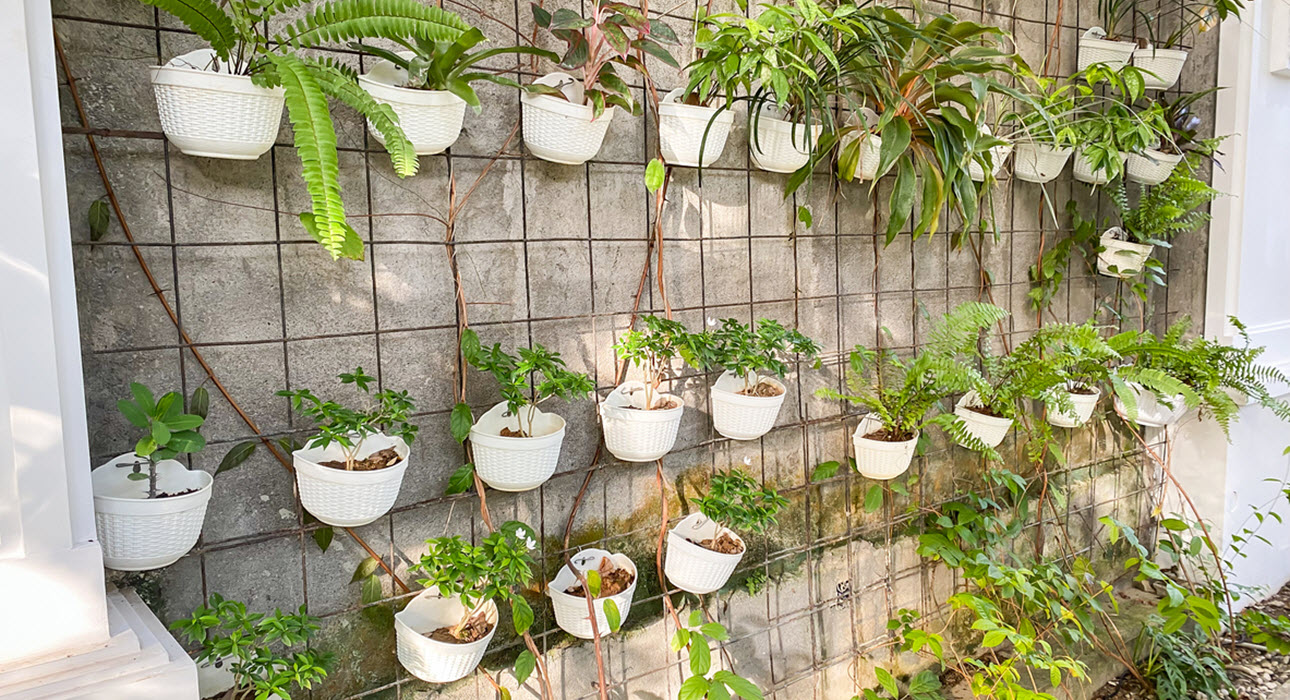
It’s no secret that urban life comes with its disadvantages when it comes to having a traditional garden, such as limited outdoor space, inadequate sunshine, and unfit soils in many cases. However, this should not deter you from having a touch of nature in your vicinity; the way to achieve this is through micro-gardening. Micro-gardening is the method of growing various garden plants, as well as vegetables, in a compact space. In simple terms, it is gardening at a miniature scale. Our team of plant professionals created this blog article to provide ideas and solutions for successful micro-gardening in Flower Mound.
Micro-Gardening Ideas and Solutions
Here’s what our landscaping experts say about various methods of micro-gardening in urban spaces:
Vertical Gardens
When a space lacks horizontal capabilities for gardening, plants can be grown vertically on surfaces and stacked on top of one another in wall-mounted pots, DIY pallet gardens, recycled shoe organizers, or modular pocket planters. This type of gardening is most suitable for various kinds of plants with shallow roots, such as leafy greens like lettuce, spinach, and kale, as well as herbs like mint, thyme, and oregano. It is also suitable for fruits like strawberries, small peppers, and tiny flowers like ivy and petunias.
It’s essential to consider several factors when opting for vertical gardening, such as:
- Ensuring the supports can bear the weight of containers, soil, plants, and the irrigation system.
- Utilizing balcony walls, fences, and even sunny indoor walls to create the structure.
- Having a drip irrigation system provides controlled, continuous, and automated watering.
- Rotating plants for even exposure to sunlight.
Pot/Container gardening
Growing plants in containers, such as pots, buckets, tubs, or recycled containers, allows for placement in diverse areas, including patios, balconies, rooftops, windowsills, and even indoor staircases. These are suitable for almost all herbs, shrubs, and dwarf plants, such as dwarf fruit trees like lemon and lime, compact vegetables like peppers, cherry tomatoes, bush beans, carrots, and radishes, as well as herbs and flowers.
Always keep these recommendations in mind:
- Ensure there’s adequate water drainage by drilling holes in the pots.
- Use high-quality potting mix soil for better aeration and growth.
- Select an OT size based on the plant’s size and its estimated growth rate.
- Arrange the plants at different heights, or use tiered plant stands to maximize the gardening space.
Windowsill Gardening
Growing small culinary herbs in pots or containers on well-lit windowsills is called windowsill gardening. Kitchen windowsills or windows exposed to sunlight for 4 to 6 hours daily are ideal locations for this garden method. Herbs like basil, mint, parsley, chives, rosemary, thyme, oregano, and cilantro, which are frequently used in cooking, are best suited for windowsill gardening. If you’re taking this approach, it’s pivotal to remember to rotate the pots so that the plants can receive sunlight evenly.
Hanging Planters
Hanging plants in baskets, pouches, or macrame holders from high places, such as ceilings, balcony railings, or wall brackets, is called hanging planter micro-gardening. Not only are these beautiful for decorative purposes, but they’re also efficient in allowing trailing plants to thrive. Strawberries, tumbling cherry tomatoes, ivy, spider plants, petunias, fuchsias, and many other creeping herbs should be grown in this type of gardening for both aesthetic appeal and the overall health of the plants. Please note that as they hang from above, water drains very quickly. Therefore, always inspect and water the plants at regular, frequent intervals to preserve their beauty and longevity.
5 Steps To Create An Appealing Micro-Garden
- Assess your surroundings and choose the plants you plan to establish. Analyze these factors:
- Gardening location
- Sunlight availability (i.e., full-sun, part-sun, shade, or indoor light)
- Plant types
- Plant growth habits (i.e., compact or dwarf)
- Prepare the soil before setting up your garden. Add additional nutrients, such as:
- Compost
- Liquid fertilizer
- Slow-release fertilizer granules
- Water the plants according to their needs (i.e., frequent or infrequent intervals).
- Rotate the plants as needed to ensure even sunlight distribution between them.
- Prevent excessive growth from harming your garden by attracting additional pests and rot by pruning when plants reach their specific growth limit. Harvesting vegetables and herbs encourages the plants to enter the next growth cycle.
Consult Landscape Express for Expert Micro-Gardening Insights
If you’re an urban dweller considering setting up a micro-garden but are overwhelmed by all the information and tasks, consult us at Landscape Express! We’ll ease your load when it comes to gardening and landscaping in Flower Mound, Texas. As a second-generation, owner-operated business, we’ve been serving this beautiful Flower Mound county, along with the surrounding areas, including Corinth, Double Oak, Roanoke, Lewisville, Argyle, Bartonville, Highland Village, Lantana, Copper Canyon, and Denton County.
At our landscaping company, we employ only the best, most experienced professional designers and crew members. Our staff delivers impeccable work in all aspects of outdoor services, including landscaping, gardening, fencing, decoration, and irrigation. Our services are excellent for personal homes, residential properties, commercial establishments, and HOAs. Are you in one of these spaces and need of a micro-garden in Flower Mound? Our qualified designers will customize and create one that caters to all of your needs, allowing you to have a little nook of green amid the concrete gray of city life.

